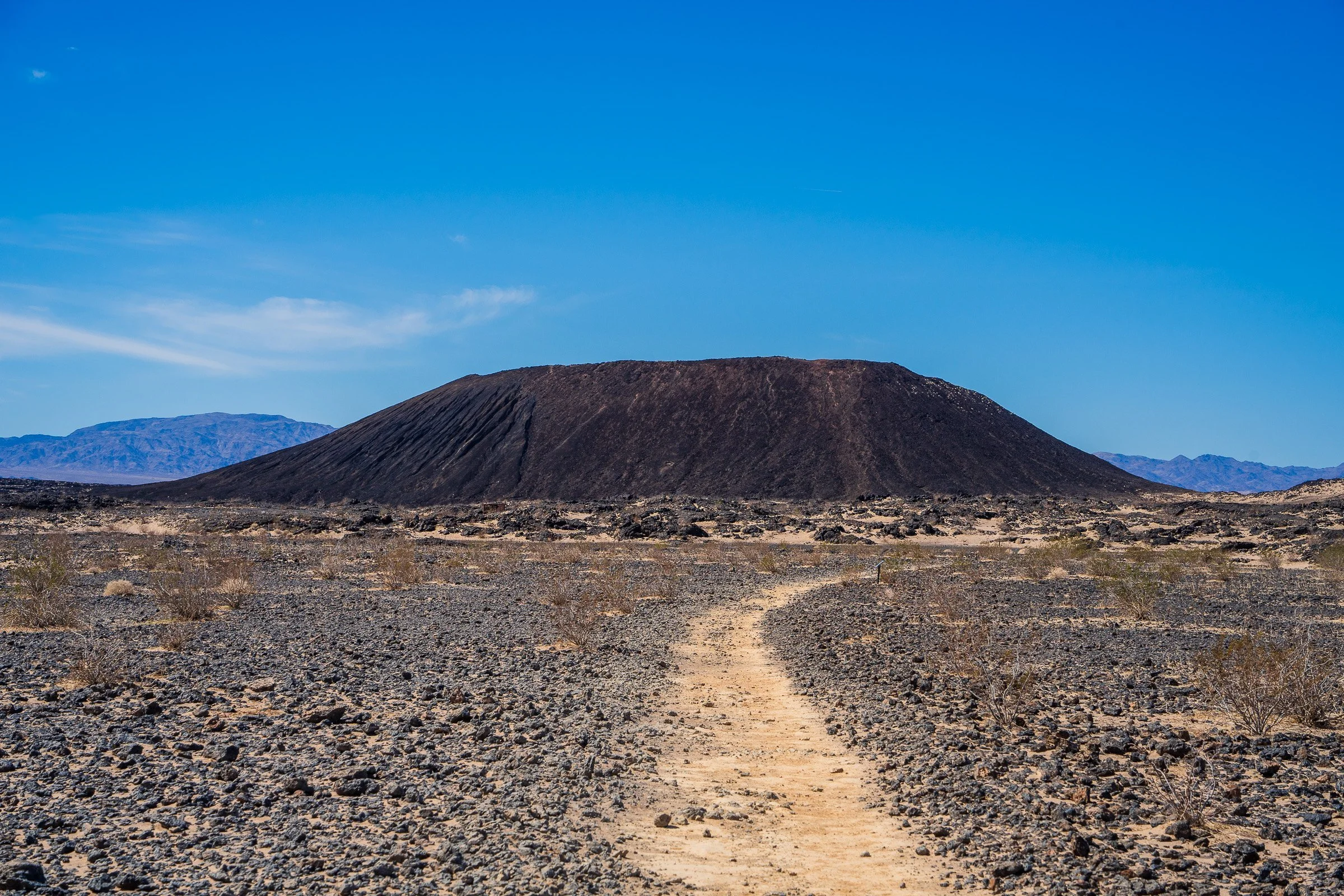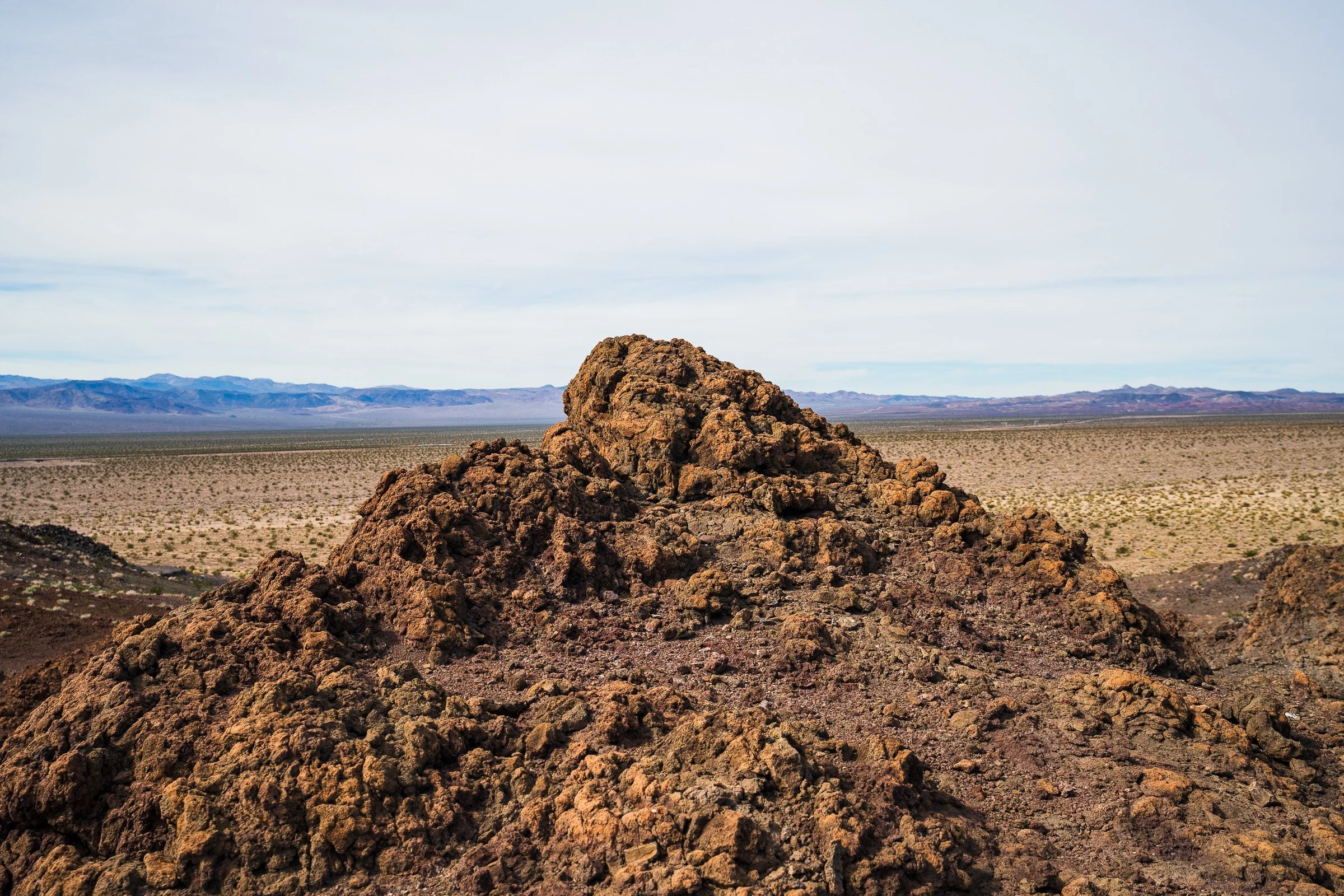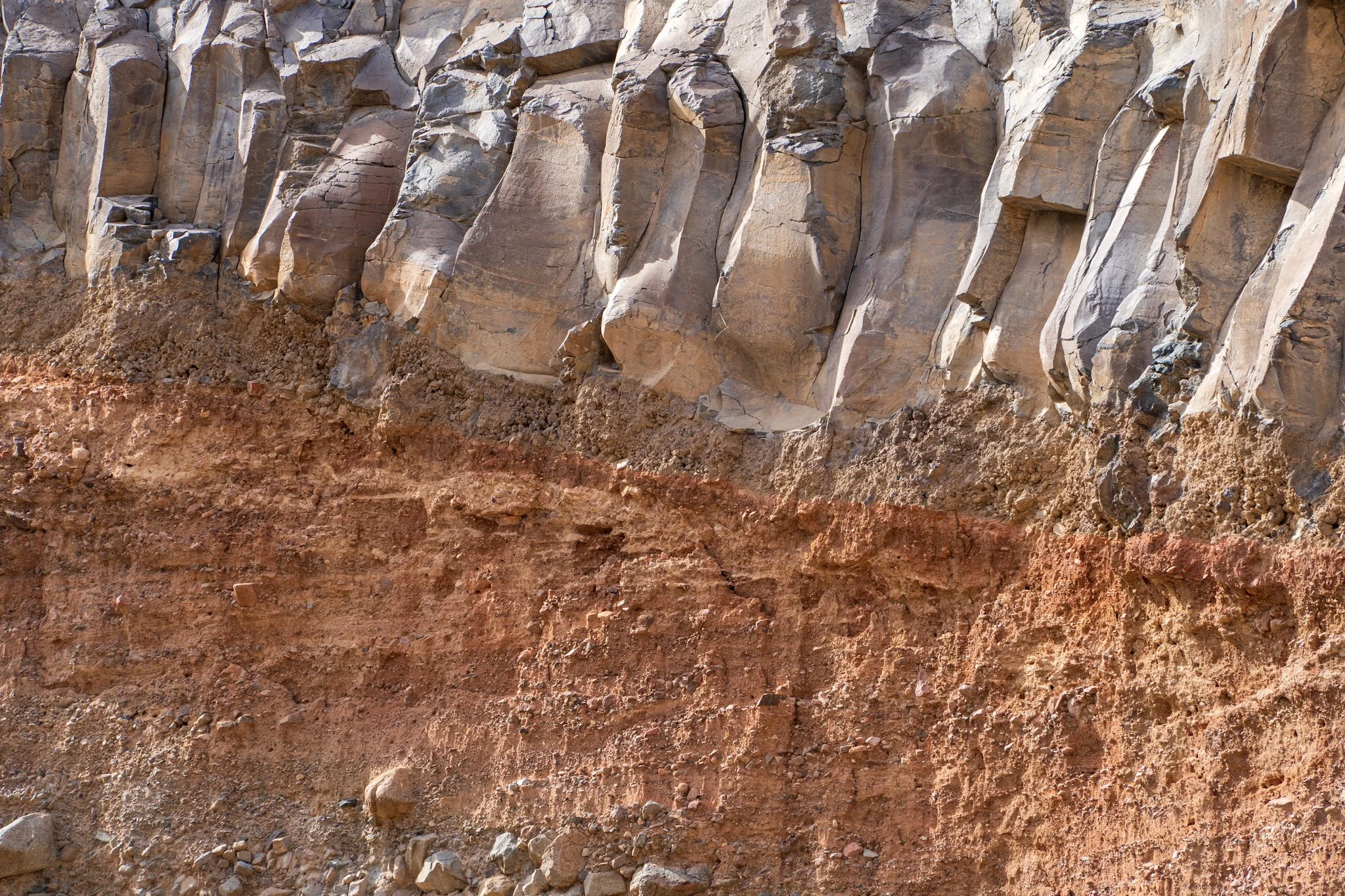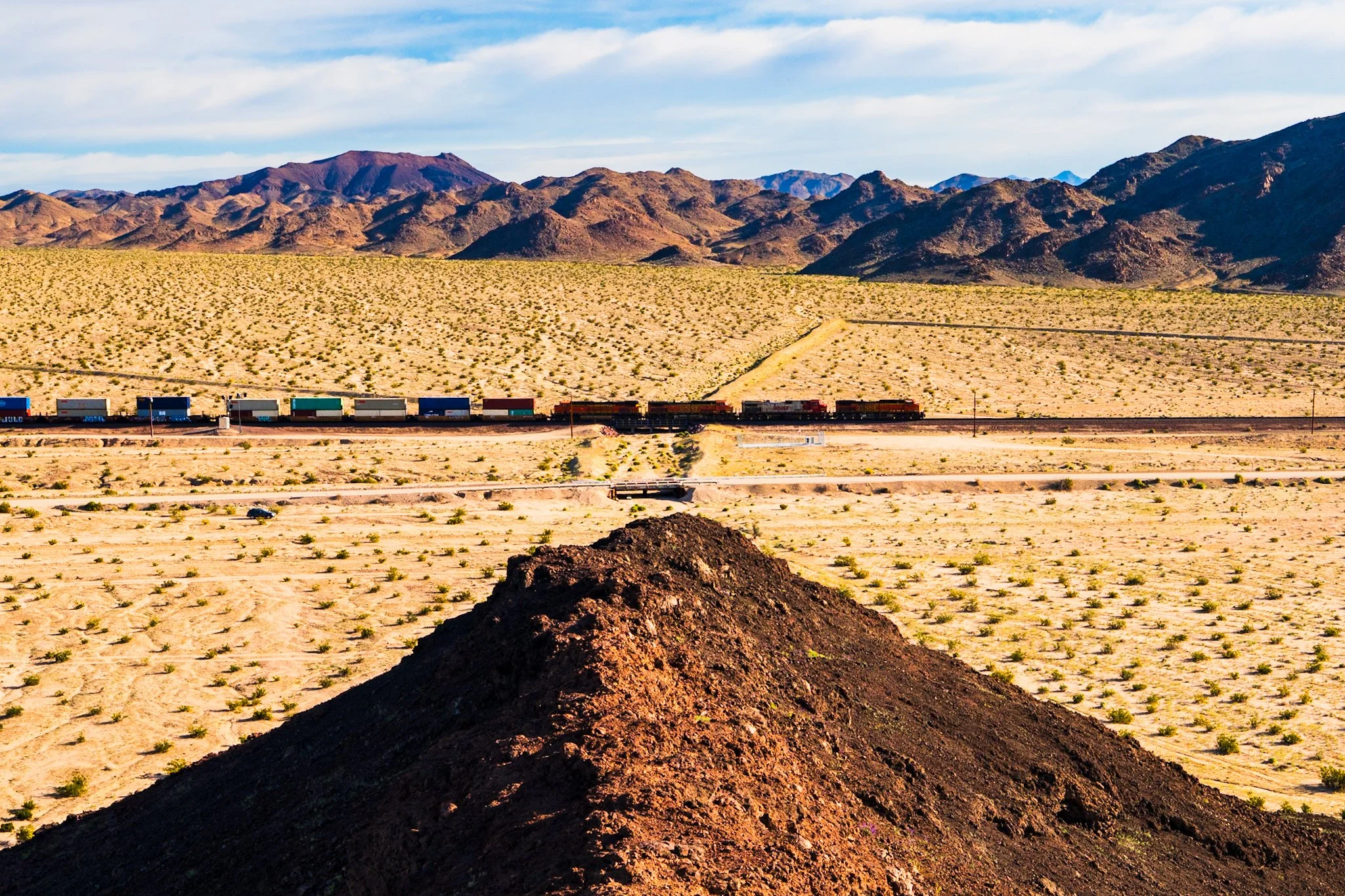
In the Flow
In Stone: An Ecology of the Inhuman, Jeffrey Jerome Cohen argues, “We think and reckon with stone, primordial invitation to extended cognition.” My recent work has tried to use encounters with concrete rocks in the field as the starting point for more abstract reflections about some of the issues brought forth by the debate around the Anthropocene, such as the need to think on a geological time frame or our entanglement with the more-than-human. For the past few years, that has meant working on a book project on the sedimentary strata of Utah’s San Rafael Swell, which I grew up next to. Here, I instead draw from my recent explorations of the quite different igneous rocks of the Mojave Desert northeast of Los Angeles.
A string of lava fields lies along the I-40 freeway and National Trails Highway, the former Highway 66, between Barstow and Amboy, California.
Amboy Crater is the most well-known of these fields. It is a National Natural Landmark with a well-maintained trail leading to the center of its cinder cone, which offers vast views of its lava flow field across the surrounding desert.
Next in reputation would be the Pisgah Crater. It might be uncannily familiar from the commercials and films shot there. Pisgah is private property, however, and has recently been closed to the public as mining has resumed.
Between these two craters and far less known, the Dish Hill Complex is perhaps the most visually astounding of these fields. It offers a trio of scoria cones: Dish Hill itself.
The unremarkably named but equally impressive Hill 1933.
And the mostly buried Hill 1069.
Around the corner from Dish Hill lies Ash Hill, the oldest of these lava fields and therefore the most complex and difficult to understand.
Finally, west of Pisgah one finds in the Rodman Mountains the Pipkin Lava Field, whose cinder cone is busily being dismantled at the Red Top Mine. With the exception of Ash Hill, these are relatively young lava fields from the Quaternary period, ranging from Dish Hill’s 2.1 million years of age to Pisgah’s fresh eruption approximately 23,000 years ago. They are just a few examples of the over 2000 Quaternary age volcanos to be found in the southwest, surely one of the defining but most unrecognized features of the region.
The magma that broke through the earth’s crust in these fields in various episodes during this time has created what might be termed a diaspora of igneous rocks that are now slowly eroding into or being covered by the surrounding dirt and sand of the Mojave Desert. The concept of a diaspora seems to assume some stable earthly, geologic backdrop, across which peoples and cultures are dispersed. However, from plate tectonics to weathering by water and wind, that seemingly stable ground is of course caught up in its own migrations operating on geological time scales usually imperceptible to humans. I would term this movement of geological material a kind of foundational “arche-diaspora.” It would only be exceeded in scope by dissemination of elemental material at the cosmological level since the Big Bang.
Dramatic volcanic eruptions in the present would most easily allow people to attribute to such geological processes the kinds of dynamism, perhaps even agency, that otherwise would be reserved for living beings in transit. As the disruption of air travel in 2010 due to an eruption in Iceland demonstrated, these igneous movements can become entangled with the atmosphere and therefore determine local weather and even climate. This most commonly occurs through the creation of a stratospheric cloud that blocks solar radiation and thereby creates cooler weather. From the massive releases of gases from basalt fields such as those involved in the Permian-Triassic Extinction Event, to the series of volcanos that may have caused the “Little Ice Age” in Europe around the 1300s, throughout geological history the arrival of this magmatic diaspora at the earth’s surface has greatly influenced global climate and thereby the movements and existence of living species.
The Mojave Desert’s diaspora of cinder cones and their surrounding lava flow fields are the semi-final destination of magma that has migrated a long distance from the upper mantle to the earth’s surface. They are scattered remnants of lithic materials that have been greatly transformed during their journey and reached relatively final settlement above ground, though the rock cycle reminds us these rocks eventually will be recycled back into other types of rocks. This is a unique journey that humans cannot follow and that still remains quite unknown. Contrary to sci-fi images of an already molten core of the planet simply bursting onto its surface, this magma began as solid rock from the mantle that melted, porously moved through the surrounding rocks until it could aggregate, and then worked its way as an upward flow that may have been repeatedly blocked or pooled and altered in composition through fractional crystallization or mixing with country rocks. This journey through the dikes and conduits of the volcanic plumbing system concluded with the final eruption and solidification on the surface. But this sometimes explosive ending also threatens to erase much of the magma’s origins and early history. This to say that the spatial depths this magma has moved through regions never observed by people resists human comprehension almost as much as the infamous abysses of geological deep time.
Whenever I reach a conceptual obstacle in my thinking or writing, my immediate response is always to turn back to the rocks themselves. In the Mojave Desert, magma as a traveler of both deep time and deep space is best figured through the xenoliths that can be found in the Dish Hill Complex. On all three of the complex’s cones and nearby flows, the igneous rocks regularly are spotted with yellow-green or orange patches.
These are xenoliths, many of which the magma has torn from the upper mantle of the earth and dragged all the way to the surface, sometimes subjecting them to low-grade metamorphism in the process. As a result, they provide a valuable glimpse of geological nether regions. “Xeno”-“Lith” means “Alien”-“Stone.” In color and chemical composition, these rocks are indeed marked by their strange difference from their igneous host rocks. But like erratics that glaciers have moved from their origin and dropped across a landscape, the xenoliths of the Dish Hill Complex feel like visitors that have wandered far from their geological homeland.
In Geopedia, Marcia Bjornerud reminds her readers that “in Greek, ‘xeno’ can also mean ‘guest.’” She concludes: “This is how I prefer to think of xenoliths: as visitors who never really intended to leave home but, having come so far, are content to stay and share stories that will help us see the world differently.” As such, they remind us of the complex stories that the entire body of igneous rocks harbors.
Whether hosting xenoliths or not, the igneous rocks of the Mojave Desert all tell stories of deep time and the movements of the earth to the humans who have subsequently encountered them. The creation of these lava fields would have preceded the arrival of the human diaspora as it spread across the globe. The first Paleo-Indians arguably reached the Mojave Desert at least 5,000 years after the youngest eruption. Although no one may have been present to witness the final stage of the magma’s reduction to rock, for the native Americans who inhabited the Mojave Desert in the last few thousand years, the final form of that rock had practical value, such as the “tanks” where water pools in even the hottest summer months, as well as cultural meaning, as is evident from the ample petroglyphs and pictographs that use the stones as surfaces for inscription.
For the visitor today, these lava fields provide a snapshot of the last stages of this long migration of magma, whose speed scientists still have difficulty measuring except at the latest stages in the upper crust. In their final lithified position, the igneous rocks nonetheless retain the ability to exhibit the energy and capacity for change that distinguished the material, which in its static, passive form is now mostly subject to the forces of erosion in the desert environment. It has become increasingly popular in recent years to appropriate geological terms for figurative language such as metaphors. One of the most common is to treat all effects as the “fossils” of previous causes. I might therefore say the igneous rocks are the fossils of the magma’s previously active existence. One of course can find plenty of such rocks at the sites of contemporary eruptions such as Iceland or Hawaii, perhaps even with some of their molten heat remaining after their recent lithic birth, or rather, magmatic death. These older rocks of the Mojave, instead, convey the traces of this dynamism across thousands to millions of years to the present. That is to say, these igneous rocks can enable an encounter with deep time that vividly expresses past change through present stasis.
Dating all the way back to James Hutton’s time, it has been a bit of a cliché in writing about geology to point out that deep time may not be truly thinkable by humans. Perhaps most influentially, John McPhee, when he coined the term “deep time” in his book Basin & Range, wrote, “The human mind may not have evolved enough to be able to comprehend deep time. It may only be able to measure it.” Nonetheless, in his recent book The Memory of the World, Ted Toadvine explores how we might phenomenologically have an experience of deep time in this form. Rather than an absolute divide between the capacities of human consciousness and the quantitively massive scales of deep time, Toadvine argues, “The materiality of our bodies embed us within the asubjective flows of the elements.” He adds, “We find ourselves at the confluence of incommensurate durations that span cosmic, geological, organic, and evolutionary scales. Our own organic rhythms are the corporeal trace of the history of life, which is itself a pulse of the world’s enduring memory.”
To conclude, I wish to survey just a few of the many forms of frozen dynamism on display in the diaspora of the Mojave lava fields. These fields feature far more rheological diversity, that is to say, material deformation, than can even be mentioned here. Yet each offers, as Toadvine argues, a different trace of the earth’s pulse and therefore potentially a different phenomenological experience of deep time. There isn’t space to fully analyze each, so I offer them to you as material figures for meditation.
The first form is the long flows of lava themselves. Most of the cinder cones have multiple flows that can sprawl out for miles in different directions. Some are rubbly 'A'ā flows that are rough and treacherous to traverse. Others are smoother pāhoehoe flows, which can be equally dangerous with their unstable shelly and slabby surfaces. Many have been so eroded or covered that they offer just smoothed igneous rocks scattered across the sand or between the desert plants. Whatever the lava morphotype, stumbling over the top of them, walking alongside their thick heights, or descending through the canyons that have been eroded into them, one retraces in human footsteps and at human speed these geological migrations. That is to say, one has the chance to move like magma, and to reach the end or to stand still is therefore to lithify oneself and become like a rock.
The Mojave’s lava field flows are not just relics of deep time but a means to think time itself.. The lava that created these flows can be treated as Bingham plastic fluids that “act as a rigid body until a certain force is applied.” The lava also typically has a solidified crust that was repeatedly penetrated or moved as the flow progressed. Rather than the cliché of “time is a river,” these lava fields therefore metaphorically offer a complex image of the passing of a time that is viscously always being held back by the past and energetically thrusting forward past its limits into the future. It is also a form of temporality that records and preserves its own unfolding.
Easier to grasp both visually and tactilely in one’s hand are individual rocks that visually reproduce on a smaller level some of the dynamism of the larger flows. The common vesicle patterns that were formed as volatiles entrapped in the magma coalesced and then were released as gas as pressure declined on the surface often give a sense of the direction of migrating lava.
More striking are the fluid patterns on the remnants of pāhoehoe flows that are often as fine as threads and filaments. Here, the low viscosity and slower movements create twisted, contorted, even what are known as “entrail” forms.
Or there is the well-known “ropey” forms of pahoehoe, created when the lava surface thickened and got squeezed by the flow behind it. Through the magma’s history, from its first melting from the mantle to its final hardening on the surface, there is a constant a negotiation in it between the thresholds of the “liquidus” and “solidus,” the temperatures where the material becomes liquid or solid, which fluctuate greatly based on pressure and chemical composition. On the conditions of the surface, solidity is inevitable for the lava, but these pāhoehoe textures again record this igneous struggle over states of matter. Although technically a solid, the final form here feels like a compromise of flux and stasis in which the latter has prevailed.
My final figure, and perhaps the least known, even to enthusiasts of volcanoes, would be “red boles.” In the intermissions between lava flows, the surface of a flow could be covered by paleosols, or its upper layer of volcanic breccia or clinker could be finely weathered. When a subsequent lava flow covered this material, the heat could “bake” it. This oxidization could then produce the hematite that gives the boles a distinct red appearance. In a large canyon north of the Pipkin Lava field, erosion has exposed one such bole that extends for hundreds of yards.
This process of baking a rock alters the material into a more homogeneous and clayey substance, but of course the most dramatic transformation is the bright color which stands in stark contrast to the grays and blacks of the rest of the igneous rocks. The physical layer of the boles emphasizes the temporal discontinuity of the lava flows. The bole also illustrates the transfer of energy from the lava to its material neighbors, which has a transformative chemical effect. Although the heat may now be gone, the color of the red bole retains the force to affect the observer. The event from deep time that produced the bole passes over the intervening time and somehow retains its potential to metamorphize those who encounter it.
The traffic that used to go down Highway 66 has almost entirely been diverted to the north with the creation of the I-40 freeway. Regardless of the prehistoric and then historic importance of this route, relatively few people now pass by these Mojave Desert lava fields, and even fewer venture out into them, with the possible exception of the Amboy Crater, which manages to draw in some of the outdoor crowd from the Mojave National Preserve to the north and Joshua Tree National Park to the south. Arguably the most regular and important traffic now are the trains on the BNSF railway. As is the case in much of the Mojave, the railroad continues down the route worked out over the last century. When heading west, the railway company’s trains pass the Amboy Crater, curve around Dish Hill, cut straight through Ash Hill, and then head west past the Pisgah Crater and Pipkin Lava Field. Rather than people, however, the trains today carry shipping containers. Since the International Union of Geological Sciences rejected calling our period the Anthropocene, I’ll have to settle for the more old-fashioned label that we live under late capitalism. In this world of frantic global trade, it is the flows of commodities that now speed past and mimic these quaternary flows of lava. Any viscous resistance that might slow down these movements or bind one to the past have been targeted for elimination. The even deeper threat of becoming solid like stone has been technologically melted into air. Thankfully, the stones themselves, which for now have paused their migrations, will remain for quite some time before being reclaimed by the desert, offering themselves as material for human reflection.























